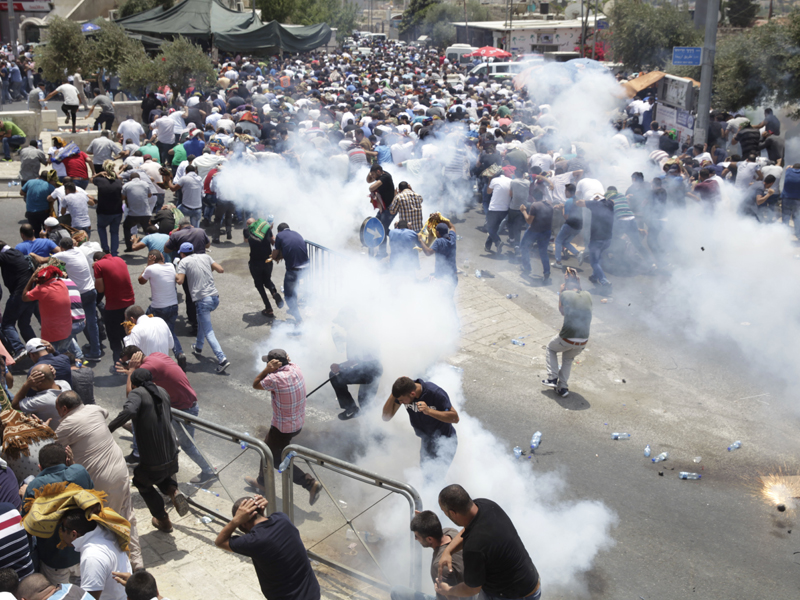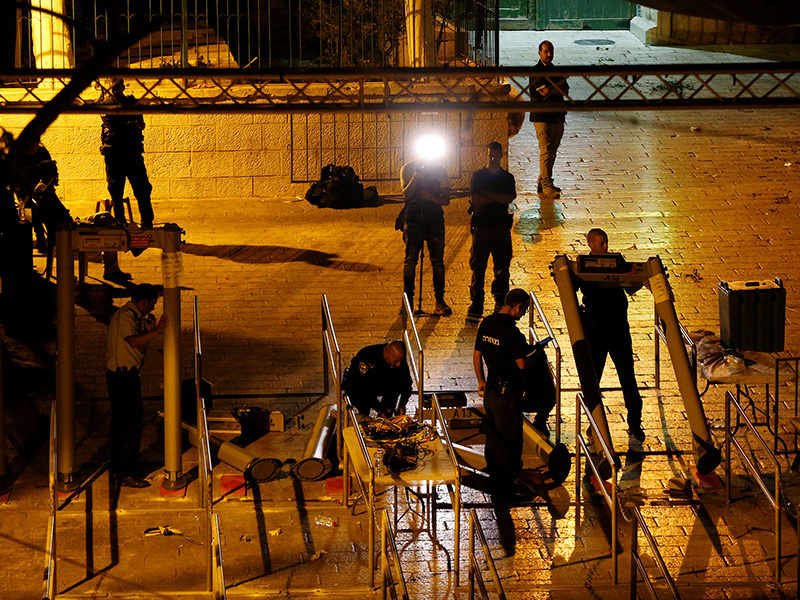
Palestinians run away from tear gas thrown by Israeli police officers outside Jerusalem’s Old City on July 21, 2017. Israel police severely restricted Muslim access to a contested shrine in Jerusalem’s Old City that day to prevent protests over the installation of metal detectors at the holy site. (AP Photo/Mahmoud Illean)
(RNS) — If you want to understand the Palestinian mini-uprising that has followed Israeli authorities’ installation of metal detectors at entrances to the Temple Mount, you need only take a short walk west, to the Church of the Holy Sepulchre.
The place where Jesus was supposedly laid to rest sets the rules for holy sites claimed by competing religious communities in Jerusalem’s Old City.
Faced with competing claims by different Christian groups, Ottoman Sultan Abdülmecid I issued a decree in 1853 apportioning control over different parts of the church and its surroundings.
Under what’s known as the “Status Quo,” the Greek Orthodox have the biggest share, with substantial portions also placed under the custody of the Roman Catholics and Armenian Christians. Lesser zones of control belong to the Coptic, Ethiopian, and Syriac Orthodox.

The “Immovable Ladder” at the Church of the Holy Sepulchre.
The emblem of the Status Quo is the so-called “Immovable Ladder,” which has stood above the facade of the church since the middle of the 18th century. The understanding is that no representative of one of the six controlling religious groups can move, rearrange or alter any piece of property without the consent of the other five.
In the 21st century alone, violence has broken out several times: when a Coptic monk moved his chair from the agreed spot into the shade (2002); when a door to the Franciscan chapel was left open (2004); when a Greek monk was ejected from the building by a rival faction (2008); when a Greek monk occupied what Armenian monks consider their space during the Feast of the Cross (2008).
You get the picture.
Like the Holy Sepulchre, the Temple Mount — known to Muslims as the Noble Sanctuary — is governed under a complicated Status Quo of its own. When the metal detectors were set up in response to three Israeli Arabs gunning down two Israeli Druze guards outside the Al-Aqsa Mosque, that was considered a violation. Ergo, violence.
Of course, there are many holy sites in the world whose violation causes devotees to rise up in anger. But only a few are claimed by rival religious communities.
The Old City of Jerusalem is dominated by such sites. If you want another example, think of the Western Wall, where violence regularly breaks out between ultra-Orthodox and non-Orthodox Jews. Just last month, Prime Minister Benjamin Netanyahu reneged on an agreement to change its Status Quo by providing a space for mixed-gender prayer.
READ: Israeli government suspends mixed-prayer plan at the Western Wall
And that’s not to mention the Jewish activists who are agitating for a new Temple to be built on the Temple Mount itself.
So on Monday Netanyahu, with an assist from King Abdullah II of Jordan, ordered the metal detectors removed. This has not mollified the other side, however.

Israeli security forces remove metal detectors which were recently installed at an entrance to the compound known to Muslims as Noble Sanctuary and to Jews as Temple Mount in Jerusalem’s Old City on July 25, 2017. Photo by Ammar Awad/Reuters
On Wednesday, a senior Muslim cleric said that “mass prayer protests would continue until the gates of the compound are opened, metal railings and an iron bridge removed and newly installed cameras taken down,” according to The New York Times.
“What’s next?” asked longtime Jerusalemite Guy Stroumsa, emeritus professor of comparative religion at the Hebrew University. “There are people on both sides who won’t stop before a full-fledged religious war starts.”
A full-fledged religious war is not what most Israelis and Palestinians want. But given the rising religious passions on both sides, restoring the Status Quo is going to be no picnic.





